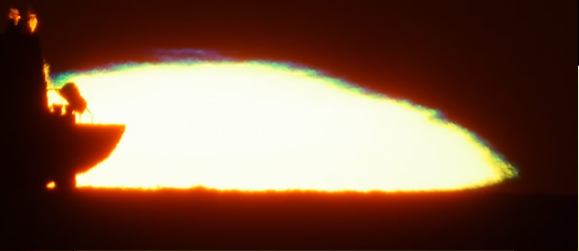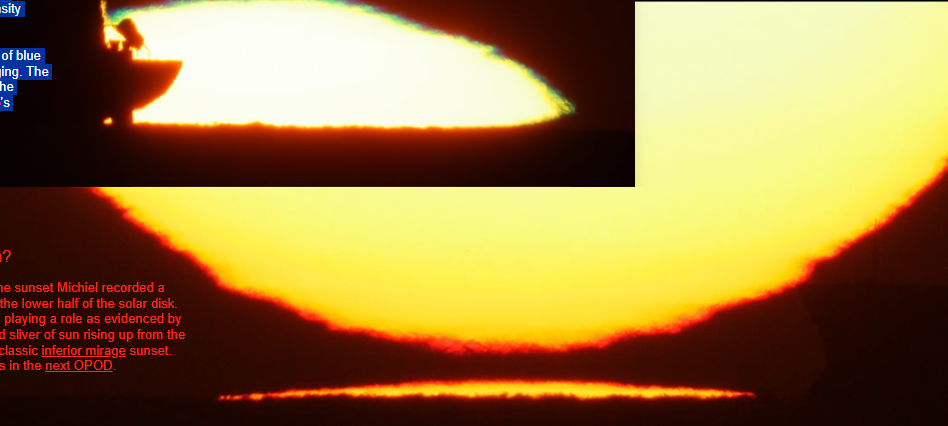Green Rim.. ..and More - OPOD
Green Rim.. ..and More - Exploring Atmospheric Optics
Have you ever witnessed a sunset where the sun appeared to have a distinctive green rim? If not, don't worry, because this phenomenon is often too narrow to be seen by the naked eye. However, with the help of a camera, Michiel de Boer captured stunning images of this unique atmospheric optics display from near Ijmuiden in The Netherlands. Let's dive into the fascinating world of the green rim and explore the other intriguing elements that can accompany it.
When we observe a green rim around the sun during sunset, it's important to note that mirages and temperature abnormalities are not necessary for its occurrence. The green rim is primarily a result of refraction, which is the bending of light as it passes through different layers of the atmosphere. As the sun sets, its rays travel at a slanting angle and refract across layers of varying density in the atmosphere. This refraction causes the rays to curve downward more steeply into the denser lower atmosphere, making the sun appear higher in the sky than its true position. In fact, normal refraction raises the sun by about half a degree during sunset.
However, refraction is not uniform for all colors of light. Blues and greens refract more than yellow and reds. As a result, the green and blue portions of the sun are raised even higher in the sky, creating the distinctive green rim. You may wonder why there isn't a blue rim as well. The reason is that the weaker blues are often absorbed or scattered during their long journey through the sunset air. So while blue rims do occasionally occur, they are much rarer compared to their green counterparts.
It's worth mentioning that green rims are sometimes mistakenly associated with the elusive green flash phenomenon. However, the green flash requires more specific conditions, namely mirage conditions. Mirage conditions occur when there are significant temperature and density gradients in the atmosphere, causing light to bend and create optical illusions. The green flash is a quick burst of green light that can be observed just as the sun disappears below the horizon. It's a captivating event that requires precise atmospheric conditions and a bit of luck to witness.
In some of Michiel de Boer's images, we can observe additional elements that contribute to the atmospheric optics display during sunset. For example, the hot exhaust from a ship can create extra temperature and density gradients in the surrounding air. This turbulence can lead to detached fragments of blue, indicating the presence of miraging. The ship's passage further contributes to the turbulent air, enhancing the overall optical effects.
In an earlier phase of the sunset, Michiel recorded a red rim on the lower half of the solar disk. This phenomenon can be attributed to miraging as well, as evidenced by the inverted sliver of sun rising up from the horizon. This type of sunset is known as a classic inferior mirage sunset. The interplay between temperature gradients and atmospheric density creates a mirage that alters the appearance of the sun, resulting in striking visual effects.
Atmospheric optics never ceases to amaze us with its intricacies and stunning displays. Whether it's the elusive green rim, the captivating green flash, or the mesmerizing mirages, each phenomenon offers a glimpse into the fascinating interplay between light and our atmosphere. So, the next time you find yourself watching a sunset, take a moment to appreciate the hidden wonders that unfold before your eyes.

Sunset Green Rim.. ..and More
Michiel de Boer (images plus) looked across the North Sea from near Ijmuiden in The Netherlands. He made these stills from 4K video.
A distinctive green rim tops the sun, distinctive that is to a camera but always too narrow to be seen by eye.
Mirages and temperature abnormalities are not needed although some are present here (see below). The air anyway thins with height and the gently slanting rays of sunset refract across layers of different density. Rays curve downwards and more steeply into the denser lower atmosphere making the sun appear raised from its true position. Normal refraction raises the sun by half a degree at sunset.
But refraction is frequency (colour) dependent. Blues and greens refract more than yellow and reds. The green and blue sun is raised highest creating the green rim. Why no blue rim? Sometimes, but rarely, there is one. Usually the weaker blues are absorbed or scattered during their long travel through the sunset air.
Green rims are too often invoked as explanations for the green flash. Flashes need more powerful stuff - mirage conditions. All images ©Michiel de Boer

Here the hot exhaust from the ship has created extra temperature and density gradients.
Detached fragments of blue speak of some miraging. The air is turbulent from the exhaust and the ship's passage

Red Rim?
Earlier in the sunset Michiel recorded a red rim on the lower half of the solar disk. Miraging is playing a role as evidenced by the inverted sliver of sun rising up from the horizon. A classic inferior mirage sunset. More of this in the next OPOD.
Note: this article has been automatically converted from the old site and may not appear as intended. You can find the original article here.
Reference Atmospheric Optics
If you use any of the definitions, information, or data presented on Atmospheric Optics, please copy the link or reference below to properly credit us as the reference source. Thank you!
-
<a href="https://atoptics.co.uk/blog/green-rim-and-more-opod/">Green Rim.. ..and More - OPOD</a>
-
"Green Rim.. ..and More - OPOD". Atmospheric Optics. Accessed on April 20, 2024. https://atoptics.co.uk/blog/green-rim-and-more-opod/.
-
"Green Rim.. ..and More - OPOD". Atmospheric Optics, https://atoptics.co.uk/blog/green-rim-and-more-opod/. Accessed 20 April, 2024
-
Green Rim.. ..and More - OPOD. Atmospheric Optics. Retrieved from https://atoptics.co.uk/blog/green-rim-and-more-opod/.